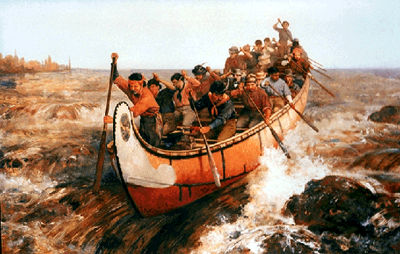
Voyageurs and Coureurs des bois
In the late 17th century, it became increasingly difficult to obtain a trading licence (known as a congé) and goods on credit. The implementation of the trading licence system in 1681 set voyageurs apart from coureurs des bois. Voyageurs were contracted by merchants or military officers with permits. Coureurs des bois, on the other hand, were typically considered outlaws of sorts because they did not have permits from colonial authorities.
Voyageurs were young men hired to transport goods to trading posts. They were forbidden to do any trading of their own. Until 1705, roughly 60 young men travelled on behalf of the Compagnie de la Colonie as far as the post of Detroit (founded in 1701). They earned a modest wage for their efforts. Like the Communauté des Habitants, which operated for about 15 years in the mid-17th century, the Compagnie de la Colonie (created in 1699) gave Canadians a monopoly over the fur trade. The Compagnie was established during a period of decline in the French market for beaver pelts and dissolved in 1706. The French then enjoyed a monopoly once again.
Voyageurs and Engagés
Later, the voyageur became a “canoe master” in charge of supervising engagés (hired workers). The engagés would transport goods from a merchant-supplier to the Pays d'en Haut (“upper country”) and then bring furs back to Montreal. Many young men from the Trois-Rivières region and areas surrounding Montreal worked in the trade each year but did so only casually. However, the sons of habitants involved in the trade typically made a career of it. Years of experience and good credit were required to become voyageurs. The company or merchant that hired a voyageur occasionally permitted him to trade for himself, which engagés normally were not allowed to do.
Merchant Voyageurs
“Merchant voyageurs” were often minor partners contracted for three years in trading companies established by merchant-suppliers and military officers. Some voyageurs were self-employed and hired only a few men to paddle one or two canoes. A number of former voyageurs — those who did not squander their earnings upon returning to town — later became sedentary merchants. They settled down and lived out their days in town or in the country.

The End of the Voyageurs
Today, the word voyageur, like the term coureur des bois, evokes the romantic image of men canoeing across the continent in search of furs. Their life was full of perilous adventure, gruelling work and cheerful camaraderie. But the fur trade changed once again in the 19th century. The number of engagés had increased to such an extent that the role of voyageur had disappeared. They were replaced by the bourgeois, who were often Scottish immigrants.
Voyageur Gear
The stereotypical voyageur outfit featuring a woven arrowhead sash is merely a product of our collective imagination. So too is the fringed-leather clothing of the coureur des bois. Voyageurs and engagés in the fur trade wore a variety of clothes over the centuries. From the early days of New France, they wore a mixture of European clothing, Indigenous garb and colonial adaptations. Certain garments disappeared over the years and were replaced by others. In the 19th century, men no longer wore the Indigenous breechcloth, which had replaced French breeches. They preferred trousers instead. However, tuques (knitted wool caps) and capotes (hooded coats) remained essential. (See also: Clothing.)
Voyageur Culture
The voyageurs left behind a significant repertoire of songs, such as “Alouette” and “C’est l’aviron qui nous mène.” The latter describes travelling through the Pays d'en Haut. Others were derived from traditional French songs. Pierre Falcon, known as “Pierre the Rhymer,” wrote many famous songs and poems about the fur trade.
Every year, festivals and events are held to commemorate the voyageurs, particularly in Western Canada. Each February, Winnipeg holds the Festival du Voyageur. It celebrates the richness of the voyageur era and the vitality of Manitoba’s francophone community. The city of Trois-Rivières, Quebec, hosts the Rendez-vous des coureurs des bois de Trois-Rivières. The event allows visitors to immerse themselves in a New France-style celebration with food, dance and traditional music.

 Share on Facebook
Share on Facebook Share on X
Share on X Share by Email
Share by Email Share on Google Classroom
Share on Google Classroom

